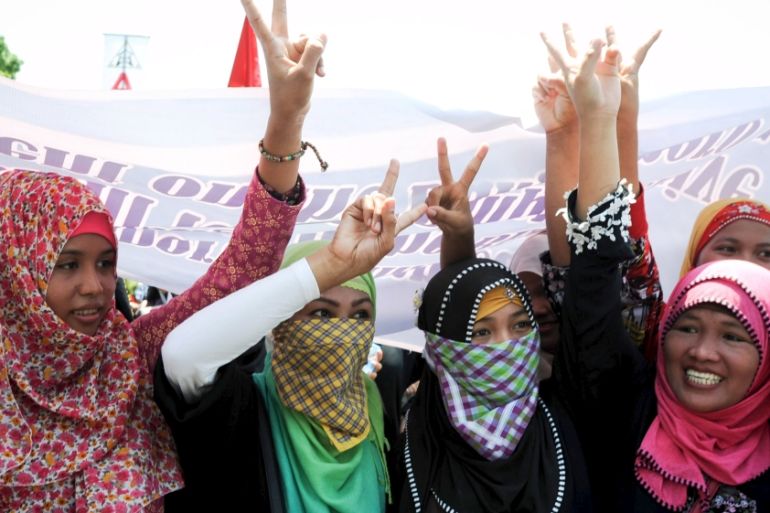Philippines’ peace process in tatters
After years of negotiations, the Philippines is now confronting the threat of renewed conflict.

The Philippines may have just lost its final chance to bring about peace to its troubled southern island of Mindanao, which has been racked by one of the world’s longest-running insurgencies. After eight months of consultations, 200 hours of debates and 51 hearings among lawmakers, the Philippine legislature failed to pass the Bangsamoro Basic Law, which would establish a new autonomous Muslim-majority political entity in Mindanao.
With the Philippines entering a new election season, most politicians even failed to show up during the deliberations and crucial vote counts. But more than the chronic absence of quorum at the legislature, the peace agreement ultimately fell victim to politicking by opposition leaders as well as grandstanding among ambitious legislatures, who didn’t share the Benigno Aquino administration’s commitment to establish the foundations of peace in the conflict-stricken south.
With the Aquino administration entering its twilight months in office, there is little guarantee that its successor will build on recent gains and find a mutually-acceptable agreement with the country’s most powerful insurgency group, the 12,000-strong Moro Islamic Liberation Front (MILF), the leadership of which has favoured negotiations over war.
Uncertain about the prospects of newly stalled peace negotiations, the Philippine government is scrambling for ways to avoid a renewed eruption of conflict in Mindanao. Both the government as well as the MILF leadership also share concerns over the potential spread of radicalism amid the deadlock in peace process, especially since various extremist groups have pledged their allegiance to the Islamic State of Iraq and the Levant (ISIL) group and declared their intent to establish a “distant caliphate” in Southeast Asia.
A tortuous history
For three centuries, Imperial Spain managed to conquer much of the Philippines, but the powerful Sultanate of Sulu always presented a formidable resistance against the European colonisers. It was not until the advent of American colonial rule in early 20th century that Muslim-majority Mindanao came rapidly under the command of Manila. The Moros were simply overwhelmed by the US’ modern military behemoth.
Amid the deadlock in the peace process, there is growing fear of potential fragmentation within the MILF ranks, as more hawkish members appear to be agitating for action.
Yet, the early decades of the Philippines’ independence saw, albeit temporarily, the establishment of a multi-civilisational country, with both the Moro leadership as well as the Catholic-majority Filipino elite jointly exploring a vision of a unified, democratic and multicultural nation.
But Manila’s quest for retaking the disputed province of Sabah from Malaysia inadvertently ended in a tragedy, the Jabidah Massacre, which re-ignited tensions between the Moro leadership and the Christian-majority elite in the capital.
Over the decades, what began as a (secular) quest for greater politico-cultural autonomy for the Muslim population of the Philippines, led by the Moro National Liberation Front (MNLF), gradually morphed into a more religion-oriented demand for independence, led by the MILF. There is no way to understate the sheer devastation and misery brought about by the ensuing conflict in southern Philippines.
Stretching over four decades, the conflict claimed as many as 150,000 lives, mostly civilian casualties, and displaced as many as two million people. Despite its fertile soil, vast mineral resources (estimated at around $1 trillion), and traditionally typhoon-proof topography, Mindanao is host to among the poorest and least-developed provinces in the Philippines.
Quest for peace
The conflict in Mindanao also carried huge strategic costs for the Philippines. The Philippine government ended up dedicating the bulk of its limited military resources to fighting insurgencies in Mindanao. And this explains why an archipelagic country like the Philippines has disproportionately invested in its ground troops and army instead of navy. This precariously deprived the Philippines of much-needed resources to defend itself against external threats, especially in light of Chinese territorial ambitions in the South China Sea.
Over time, however, successive Filipino administration managed to negotiate peace agreements with the key rebel groups. The Aquino administration, which came to power on the promise of change and genuine reform, embarked on a courageous and creative attempt to explore lasting peace in Mindanao.
OPINION: The Philippines delicately wedged between US and China
What began as low-key negotiations with the MILF leadership quickly evolved into comprehensive negotiations for eventual disarmament, demobilisation, and reintegration of rebel groups in exchange for the establishment of a “Bangsamoro” (Moro’s nation) political entity in Muslim-majority areas of Mindanao.
Right until the beginning of 2015, the peace negotiations were on board, with the protagonists relishing massive support among external powers as well as the majority of the Filipino population. But the Aquino administration’s decision to push ahead with a (botched) counterterror operation in a rebel-held area, however, scuttled the entire peace process.
Uncertain road ahead
The Mamasapano tragedy, which ended in the massacre of 44 members of the elite Special Action Force (SAF), soured popular mood towards MILF and the peace negotiations. And ambitious politicians were quick to tap into the new popular sentiment. It didn’t take long before a growing number of legislators began withdrawing support for ratifying the Bangsamoro Basic Law, which represented the legal foundation of the whole peace process. The tragedy also led to growing calls for the resignation of top government officials, including the president.
OPINION: China’s regional isolation
After more than a year of incessant lobbying, the government failed to achieve legislative support for the establishment of a Bangsamoro political entity, which became a subject of fierce constitutional debates and even quasi-fearmongering. Amid the deadlock in the peace process, there is growing fear of potential fragmentation within the MILF ranks, as more hawkish members appear to be agitating for action.

Even more seriously, there is an immediate concern over the emergence of a potential political vacuum that could facilitate the cause of radical splinter groups, which have begun consolidating their ranks in order to push for the establishment of a “distant caliphate” in Mindanao.
After years of excruciating negotiations, which temporarily held the promise of lasting peace, the Philippines is now confronting the twin threat of renewed conflict and re-emergence of extremist groups.
Richard Javad Heydarian is a specialist in Asian geopolitical/economic affairs and author of Asia’s New Battlefield: US, China, and the Struggle for Western Pacific.
The views expressed in this article are the author’s own and do not necessarily reflect Al Jazeera’s editorial policy.
